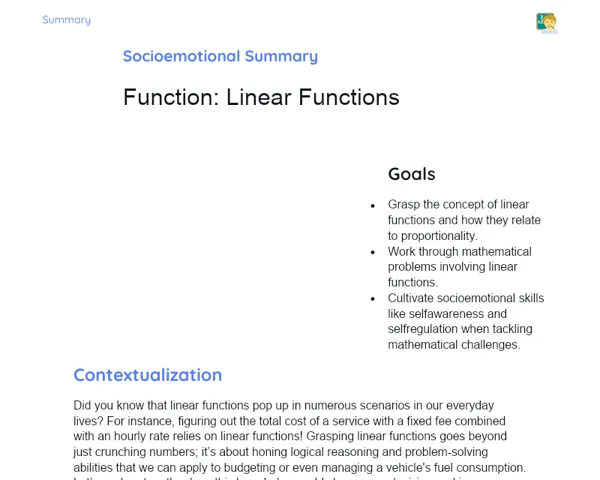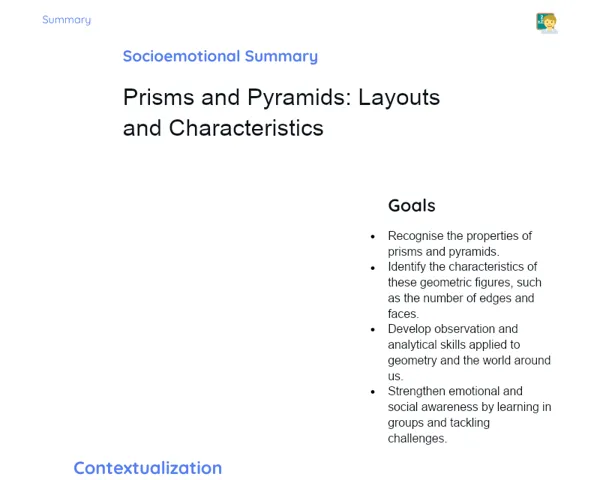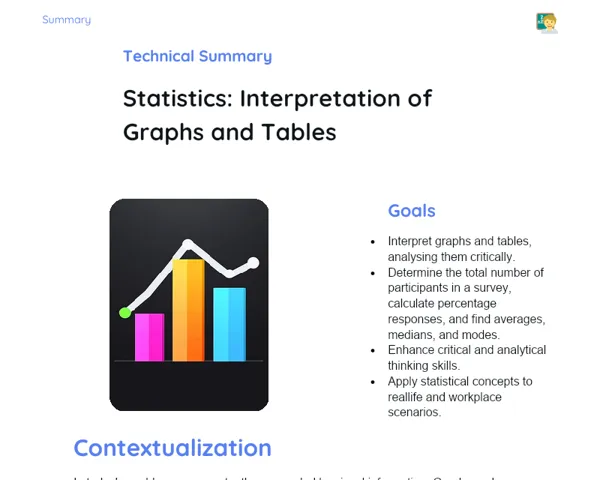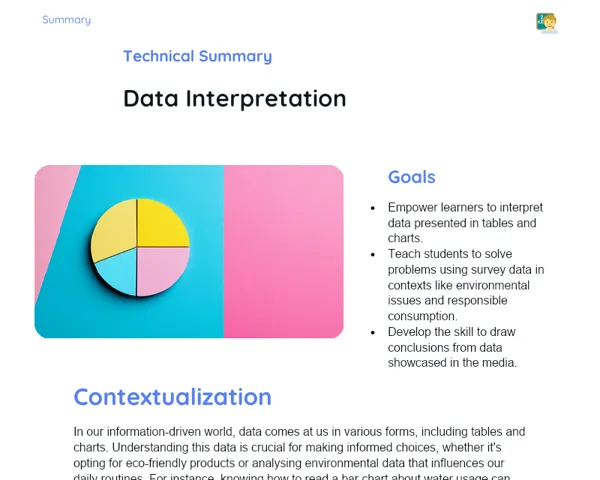Summary Tradisional | First Degree Inequality
Contextualization
First-degree inequalities are vital mathematical tools that assist us in expressing and making decisions under certain conditions. They involve a variable, usually denoted as 'x', and incorporate inequality symbols such as >, <, ≥, and ≤. The typical form of a first-degree inequality is ax + b > c, where 'a', 'b', and 'c' are real numbers and 'a' is not equal to zero. These inequalities are particularly useful for articulating scenarios where something needs to be greater, less than, or equal to a particular value.
In our daily lives, we often come across examples of inequalities, such as establishing the minimum quantity of goods that must be sold to achieve a certain profit or weighing different investment options. Additionally, inequalities find widespread application in fields such as economics, engineering, and computer science. Grasping how to solve and apply these inequalities is essential for fostering critical problem-solving and decision-making skills.
To Remember!
Definition of First-Degree Inequality
A first-degree inequality is a mathematical expression that employs inequality symbols (> , < , ≥ , ≤) and includes a variable, usually denoted as 'x'. The general form of these inequalities is ax + b > c, where 'a', 'b', and 'c' are real numbers and 'a' is not equal to zero. The key feature of first-degree inequalities is that the variable is raised to the first power, meaning it isn’t squared or raised to a higher power.
To clarify, consider the inequality 2x - 4 > 6. Here, 'a' is 2, 'b' is -4, and 'c' is 6. The objective is to discover the values of 'x' that validate the inequality. Unlike equations, which offer a definitive solution, inequalities generally yield a range of solutions. This indicates that the answer can comprise a set of numbers that fulfil the inequality.
Inequalities are vital across various sectors, such as economics, engineering, and computer science, allowing us to express conditions that must be satisfied. For instance, they can be used to ascertain the minimum amount of a resource necessary to meet a target or assess a project's viability.
Comprehending the definition and structure of first-degree inequalities is crucial for solving problems involving specific conditions and making informed decisions.
-
Mathematical expression that employs inequality symbols (> , < , ≥ , ≤).
-
Involves a variable, usually designated as 'x'.
-
The general form is ax + b > c, where 'a', 'b', and 'c' are real numbers and 'a' is not equal to zero.
Basic Properties of Inequalities
First-degree inequalities adhere to several important properties that facilitate manipulation and resolution. One fundamental property is that we can add or subtract the same value to both sides of the inequality without changing its truth. For example, with the inequality 2x - 4 > 6, we can add 4 to both sides, leading to 2x > 10.
Another significant property pertains to multiplication and division. We can multiply or divide both sides by a positive number without altering the inequality sign. However, if we multiply or divide by a negative number, we must reverse the inequality sign. For instance, in the inequality -2x > -8, dividing both sides by -2 changes it to x < 4.
These properties are fundamental for simplifying and solving inequalities. They allow us to transform the inequality into a more manageable form where the solution can be identified easily. Understanding these properties also helps to avoid typical errors, such as neglecting to reverse the inequality sign when handling a negative number.
Gaining mastery of the basic properties of inequalities is an important step towards solving mathematical problems that entail specific conditions and ensuring that solutions are both accurate and reliable.
-
We can add or subtract the same value to both sides of the inequality.
-
Multiplying or dividing both sides by a positive number keeps the inequality sign unchanged.
-
Multiplying or dividing by a negative number necessitates reversing the inequality sign.
Solving First-Degree Inequalities
To solve a first-degree inequality, we adopt a systematic approach that involves applying the fundamental properties of inequalities. Our goal is to isolate the variable on one side of the inequality, akin to solving equations. Let’s illustrate this with a practical example: 2x - 4 > 6.
We begin by adding 4 to both sides to remove the constant term from the left side: 2x - 4 + 4 > 6 + 4, resulting in 2x > 10. Next, we divide both sides of the inequality by 2 to isolate 'x': 2x/2 > 10/2, yielding x > 5.
The solution to this inequality is x > 5, which signifies all values of 'x' that are greater than 5. This solution can be graphically represented on a number line with an open circle indicating 5 and shading all numbers to the right. This denotes that 5 is not included in the solution, but all values greater than 5 are.
Understanding and practicing solving first-degree inequalities is fundamental for tackling problems that involve conditions of inequality. This systematic process guarantees that the solution derived is accurate and applicable in real-world scenarios.
-
Add or subtract terms to simplify the inequality.
-
Multiply or divide by constants to isolate the variable.
-
Graphically represent solutions on a number line.
Practical Applications of First-Degree Inequalities
First-degree inequalities find numerous practical applications in various fields and everyday life. They are frequently employed to resolve problems involving conditions of inequality, such as determining minimum or maximum limits for specific variables. For example, in economics, inequalities can help calculate the break-even point between revenue and expenditure or decide the minimum quantities of products needed to turn a profit.
In engineering, inequalities are instrumental for ensuring that structures are both safe and efficient. For instance, when constructing a bridge, we need to confirm that the strength of the materials exceeds the load the bridge will bear. This can be depicted by a first-degree inequality that assures the safety requirement is met.
Within computer science, inequalities are utilized in algorithms to optimize processes and resources. For instance, while developing a search algorithm, it may be crucial to guarantee that the execution time remains below a specific value, which can be articulated as a first-degree inequality.
Understanding and applying first-degree inequalities in practical contexts is key for resolving real issues and making informed decisions. These skills are invaluable across various careers and everyday applications, underscoring the significance of studying first-degree inequalities as part of the mathematics curricula.
-
Utilized to tackle problems with conditions of inequality.
-
Applications span economics, engineering, and computer science.
-
Essential for making informed decisions and addressing real challenges.
Key Terms
-
First-Degree Inequality: Mathematical expression that employs inequality symbols and involves a variable.
-
Inequality Symbols: Symbols utilized in inequalities (> , < , ≥ , ≤) to indicate the relationship between values.
-
Properties of Inequalities: Rules governing the addition, subtraction, multiplication, and division of terms within the inequality.
-
Graphical Representation: Method for illustrating the solution of an inequality on a number line.
Important Conclusions
Throughout the lesson, we explored the definition of first-degree inequalities, their fundamental properties, and the systematic approach to solving them. Grasping these inequalities is of utmost importance, as they facilitate representing and resolving inequality conditions that arise in diverse practical contexts, such as economics, engineering, and computer science.
By applying the principles of first-degree inequalities to everyday challenges, such as ascertaining the minimum quantity of products needed for profitability, we illustrate how these mathematical tools are instrumental for making informed decisions. The graphical depiction of solutions also enhances our ability to visualize and interpret the outcomes.
The significance of mastering first-degree inequalities transcends theoretical mathematics, extending to practical situations requiring precise and effective solutions. We encourage everyone to continue delving into this topic to bolster their problem-solving capabilities and apply this knowledge in their careers and everyday life.
Study Tips
-
Review the examples and exercises completed in class to reinforce understanding of the properties and methods for solving first-degree inequalities.
-
Practice solving additional problems involving first-degree inequalities, especially those that relate to real-world scenarios.
-
Utilize supplementary resources, such as educational videos and online materials, to examine different methods and strategies for solving inequalities and comprehending their applications in various fields.



